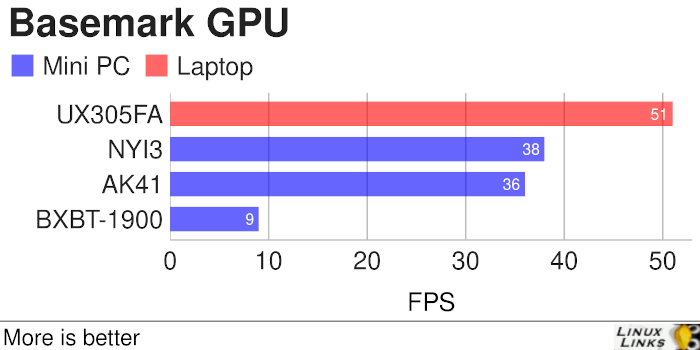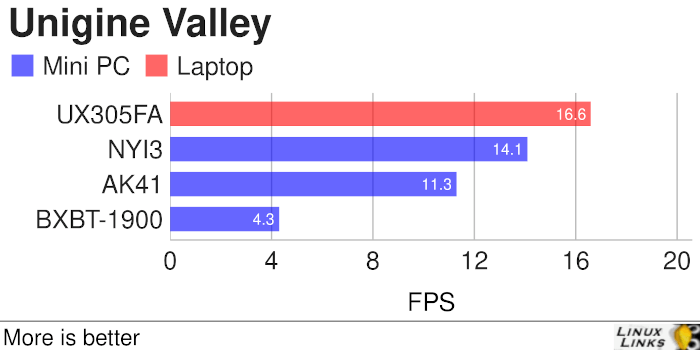Last Updated on September 6, 2020
Graphics
The AWOW AK41 uses UHD Graphics 605, a mobile integrated graphics solution by Intel, launched in December 2017. It’s built on the 14 nm process, and based on the Gemini Lake GT1.5 graphics processor. The UHD Graphics 605 is equipped with 18 Execution Units (EUs) running at up to 750 MHz. Due to its lack of dedicated graphics memory or eDRAM cache, the UHD 605 has to access the main memory via processor. The video engine decodes H.265/HEVC (8b and 10b) and VP9 completely in hardware.
I’m only going to run a few tests, as it should be obvious that these types of onboard graphics are not going to achieve high frame rates on many of the latest games at ultra graphics settings.
Both the tests below are extremely demanding on a system’s integrated graphics card.
Basemark GPU is a professional evaluation tool to evaluate and compare graphics performance across mobile and desktop platforms. The benchmark was run at 1280×720 full screen.


The AK41 puts in a credible performance, although it’s beaten to first place by the Asus laptop.
The next test calculates the average frame-rate within the Valley demo for the Unigine engine. Unigine Valley relies upon an OpenGL 3 core profile context.

While the frames per second score for all machines are very low, that’s common with most Intel integrated graphics. But there are many games you can play on Intel integrated graphics. I will cover some of my favourites in a later article, and see how they fare on the AK41.
Pages in this article:
Page 1 – Introduction / System
Page 2 – Processor
Page 3 – Memory
Page 4 – Graphics
Page 5 – Disk
| AWOW AK41 | |
|---|---|
| Type | Mini PC |
| Processor | Intel Celeron J4115 running at 1.80GHz (Turbo 2.5 GHz) with 4 cores and 4 threads |
| Chipset | Intel Gemini Lake |
| Memory | 8GB DDR4 (2133 MHz) |
| Graphics | Intel UHD Graphics 605 |
| Disk | 128GB Foresee NVMe M.2 SSD F900F128GBH |
| AWOW NYI3 | Gigabyte BXBT-1900 | Asus UX305FA | |
|---|---|---|---|
| Type | Mini PC | Mini PC | Laptop |
| Processor | Intel Core i3-5005U 2.00GHz 2 cores 4 threads | Intel Celeron J1900 2.00GHz (Turbo 2.416 GHz) 4 cores 4 threads | Intel Core M-5Y10c 0.8GHz (Turbo 2.00GHz) 2 cores 4 threads |
| Chipset | Intel Broadwell | Intel Atom Z36xxx/Z37xxx | Intel Broadwell-U-OPI |
| Memory | 8GB DDR4 (1600 MHz) | 4GB DDR3 (1600 MHz) | 8GB DDR3 (1866 MHz) |
| Graphics | Intel HD Graphics 5500 | Intel HD 2GB | Intel HD Graphics 5300 |
| Disk | 128GB Kingston NVMe | 250GB Samsung SSD 860 | 128GB SanDisk SSD |
Complete list of articles in this series:
| AWOW AK41 Mini PC | |
|---|---|
| Week 11 | Video consoles: SNES emulation |
| Week 10 | Running TeamViewer with AWOW AK41 as the host |
| Week 9 | Astronomy on the AK41 including Celestia, Stellarium, Skychart, and more |
| Week 8 | Recording video with OBS Studio |
| Week 7 | Home computer emulators: FS-UAE, ZEsaurUX, Hatari, Clock Signal |
| Week 6 | Web browsing with Chrome, Firefox, Opera, and Vivaldi |
| Week 5 | Gaming: SuperTuxKart, AwesomeNauts, Retrocycles, Robocraft, DOTA 2, and more |
| Week 4 | Run multiple operating systems on the AK41 |
| Week 3 | Video and audio playback looking at hardware acceleration |
| Week 2 | Benchmarking the AK41 with 3 other low power machines |
| Week 1 | Introduction to the series including wiping Windows and installing Manjaro |
This blog is written on the AWOW AK41 Mini PC.

Were the tests run with the powersave CPU scaling governor?
Yes, all tests on each machine used the powersave governor. While it’s possible the benchmarks would be (slightly) higher with the performance governor, the powersave governor is the default on the system.